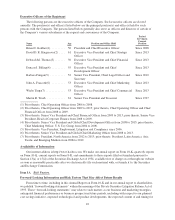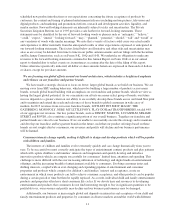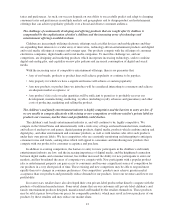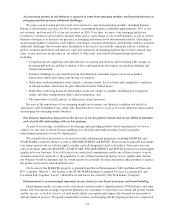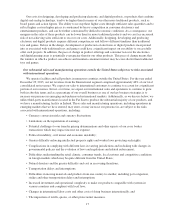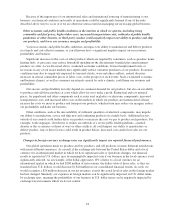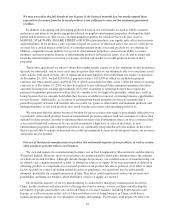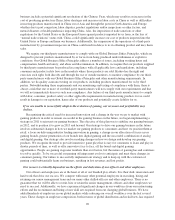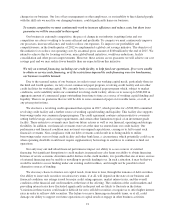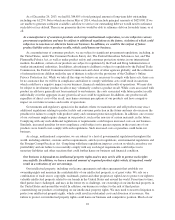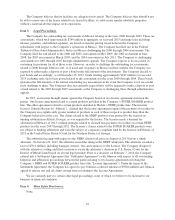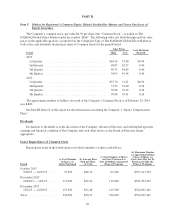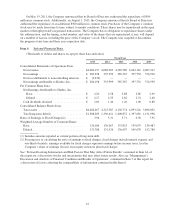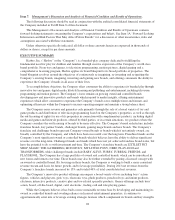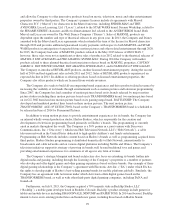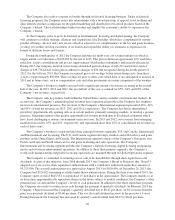Hasbro 2013 Annual Report Download - page 32
Download and view the complete annual report
Please find page 32 of the 2013 Hasbro annual report below. You can navigate through the pages in the report by either clicking on the pages listed below, or by using the keyword search tool below to find specific information within the annual report.business include a potential significant revaluation of the Chinese Yuan, which may result in an increase in the
cost of producing products in China, labor shortages and increases in labor costs in China as well as difficulties
in moving products manufactured in China out of Asia and through the ports in North America and Europe,
whether due to port congestion, labor disputes, product regulations and/or inspections or other factors, and
natural disasters or health pandemics impacting China. Also, the imposition of trade sanctions or other
regulations by the United States or the European Union against products imported by us from, or the loss of
“normal trade relations” status with, China, could significantly increase our cost of products imported into the
United States or Europe and harm our business. Additionally, the suspension of the operations of a third-party
manufacturer by government inspectors in China could result in delays to us in obtaining product and may harm
sales.
We require our third-party manufacturers to comply with our Global Business Ethics Principles, which are
designed to prevent products manufactured by or for us from being produced under inhumane or exploitive
conditions. Our Global Business Ethics Principles address a number of issues, including working hours and
compensation, health and safety, and abuse and discrimination. In addition, we require that our products supplied
by third-party manufacturers be produced in compliance with all applicable laws and regulations, including
consumer and product safety laws in the markets where those products are sold. Hasbro has the right and
exercises such right, both directly and through the use of outside monitors, to monitor compliance by our third-
party manufacturers with our Global Business Ethics Principles and other manufacturing requirements. In
addition, we do quality assurance testing on our products, including products manufactured for us by third
parties. Notwithstanding these requirements and our monitoring and testing of compliance with them, there is
always a risk that one or more of our third-party manufacturers will not comply with our requirements and that
we will not immediately discover such non-compliance. Any failure of our third-party manufacturers to comply
with labor, consumer, product safety or other applicable requirements in manufacturing products for us could
result in damage to our reputation, harm sales of our products and potentially create liability for us.
If we are unable to successfully adapt to the evolution of gaming, our revenues and profitability may
decline.
Recognizing the critical need for increased innovation and a change in the way we go to market with
gaming products in order to remain successful in the gaming business in the future, we began implementing a
strategy in 2011 to reinvent our gaming business. The objective of this plan was to stabilize our gaming business
in 2012, and to position it to grow in 2013 and beyond. Our strategy to drive our gaming business in the future
involves substantial changes in how we market our gaming products to consumers and how we position them at
retail, a focus on delivering industry leading innovation in gaming, a change in our allocation of focus across
gaming brands, greater penetration of our brands into digital gaming and the successful combination of analog
and digital gaming. Our strategy also involves making changes in how we design and develop our gaming
products. We recognize the need to provide immersive game play that is easy for consumers to learn and play in
shorter periods of time, as well as offer innovative face to face, off the board and digital gaming
opportunities. People are gaming in greater numbers than ever before, but the nature of gaming has and continues
to evolve quickly. To be successful our gaming offerings must evolve to anticipate and meet these changes in
consumer gaming. Our failure to successfully implement our strategy and to keep up with the evolution of
gaming could substantially harm our business, resulting in lost revenues and lost profits.
Our success is critically dependent on the efforts and dedication of our officers and other employees.
Our officers and employees are at the heart of all of our branded play efforts. It is their skill, innovation and
hard work that drive our success. We compete with many other potential employers in recruiting, hiring and
retaining our senior management team and our many other skilled officers and other employees. There is no
guarantee that we will be able to recruit, hire or retain the senior management, officers and other employees we
need to succeed. Additionally, we have experienced significant changes in our workforce from our restructuring
efforts and the recruitment and hiring of new skill sets required from our changing global business. We have
added hundreds of employees in our global markets while reducing our overall workforce over the last several
years. These changes in employee composition, both in terms of global distribution and in skill sets, has required
20


